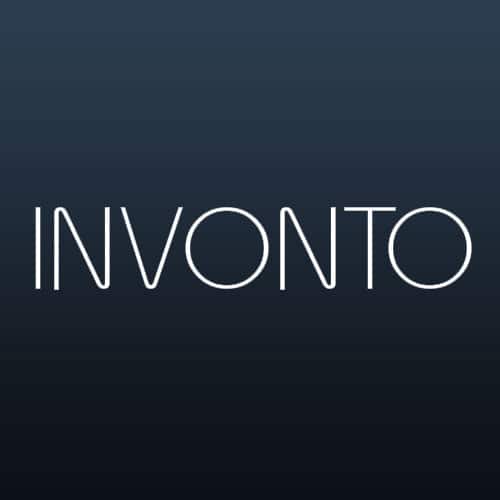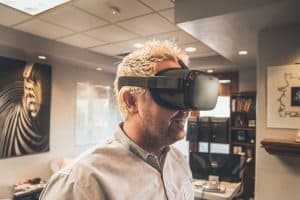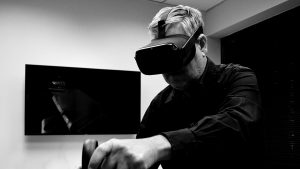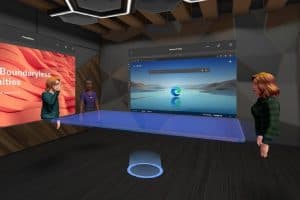Transform Business Collaboration Using Virtual Reality Technology
Virtual Reality in Construction Safety
The construction industry is a notoriously hazardous workplace. Today, more construction companies are trying to reduce the number of onsite fatalities. Employers are exploring virtual reality applications for construction safety training. Virtual reality safety training offers an interactive risk-free environment to train employees. With virtual reality apps, new employees can learn how to use equipment and follow safety procedures. Experienced employees can maintain safety and security protocols as they evolve. Virtual reality simulations remove the risk of damaging equipment or causing injuries. Current construction training programs are expensive to fund. Virtual reality apps reduce the need for costly equipment and improve training accessibility. With virtual reality, construction safety training becomes less costly, less risky, and more efficient.
Construction Safety Training VR Experience
Invonto’s virtual reality app development team creates VR applications that solve business problems. We have built training simulations, VR walkthroughs, 3D models, and 360 videos. We also have years of experience building custom web and mobile applications for construction companies. With our expertise, we set a goal to create a construction safety training VR app. The VR experience would use gamification to make the construction safety training interactive and engaging.
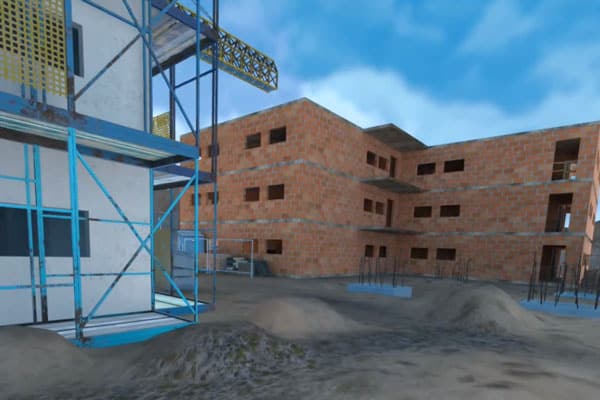
Simulating PPE Training in Virtual Reality
We wanted our virtual reality app to teach the importance of personal protection equipment (PPE). PPE includes hard hats, boots, glasses, and vests. The VR simulation teaches workers how to “gear up” to meet the safety guidelines before entering a live construction site. It sounds simple, but you’d be surprised how many injuries occur because safety procedures are ignored. In the VR app, a user enters a 3D model of a training room. They are asked to grab equipment that is important for construction safety. Using the Oculus Quest controllers, the user must walk around the space to find and interact with the proper PPE. The door to enter the construction site will automatically unlock when the user has grabbed PPE to meet the safety checklist. This VR project will help reduce the number of workers who neglect to follow safety equipment procedures.
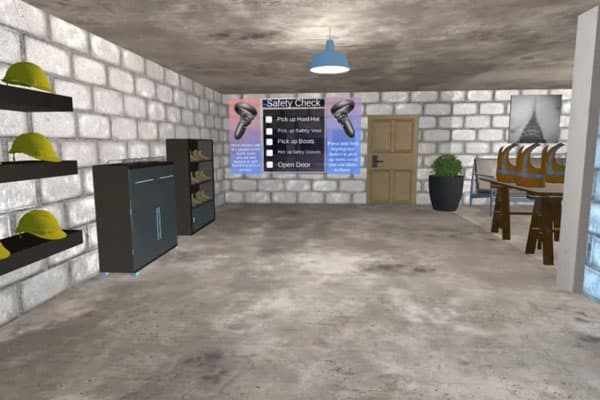
Choosing a VR Platform
We examined several available virtual reality platforms. The Oculus VR headset provided the most robust development environment. Compared to the HTC Vive, Oculus VR headsets were less expensive for consumers. The low cost makes the product more accessible for enterprise projects. Oculus also has well-rounded integration with Unity 3D. Unity is one of the best object-oriented programming platforms. Every virtual reality project needs a source control system. We originally chose Git to manage our source code. It worked well, until we started filling the environment with 3D objects. The 3D objects and lightmaps were heavy file sizes and caused issues with Git. The alternative source control system was Perforce, which worked remarkably well. Perforce is a free source control system capable of handling large file sizes. Similar to Git, you and your team can access files from any location. Perforce also allows you to create a cloud server or machine server. This project was managed using Teamwork. It is a robust project management system that we use for all our projects.
Sourcing Our 3D Assets
We relied on the Unity Asset Store to build the construction site. The Unity asset store offers scene-ready assets to build a virtual environment. Selecting prefab assets for our construction safety training VR app helped us focus on creating the interactive experience.
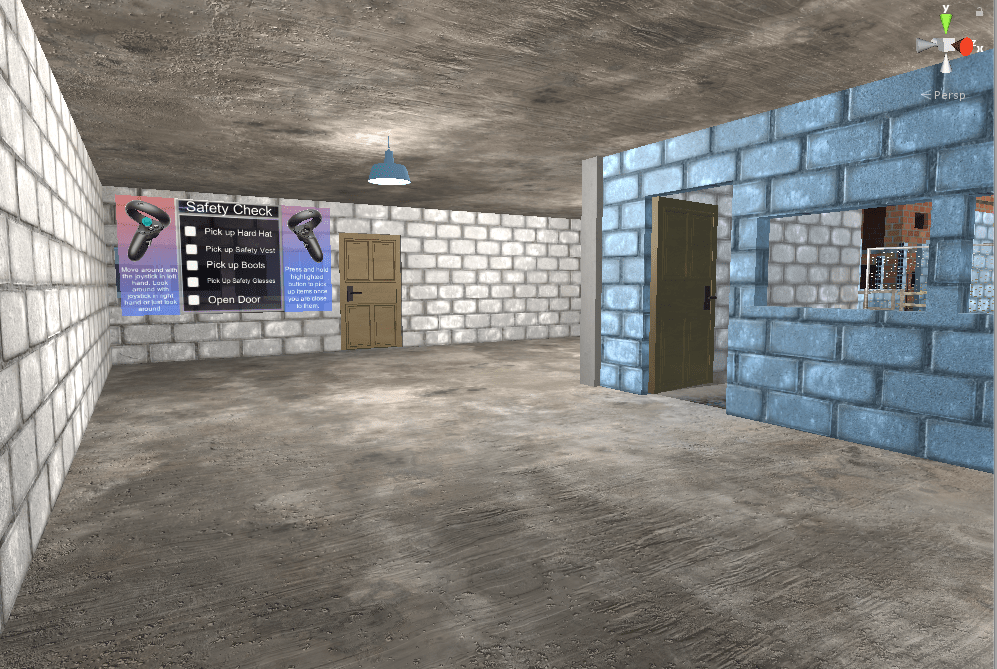
To build the training room, we identified an open area within the construction site. We used prefab assets to build the training room. We filled the training room with objects such as tables, cabinets, wall art, light fixtures, and plants to bring the room to life! We chose objects that replicate the appearance of a construction site. When placing assets, we were mindful of scale and layout. We found these assets on both the Unity Asset Store and Turbosquid.
In our video, you may notice that the PPE disappears after interacting with it. Within the environment, we added a function that destroys the object. The end result is an effect that simulates a user putting on the equipment.
Lighting Up The VR Environment
Lighting plays an important factor in making a realistic virtual reality environment. Some objects use natural light. The outdoor environment relies on scene lighting. For the training room, we added light fixture objects to demonstrate the visual effects. After several rounds of testing and adjustments, we achieved the desired lighting for the interiors of the construction buildings and outdoor space.
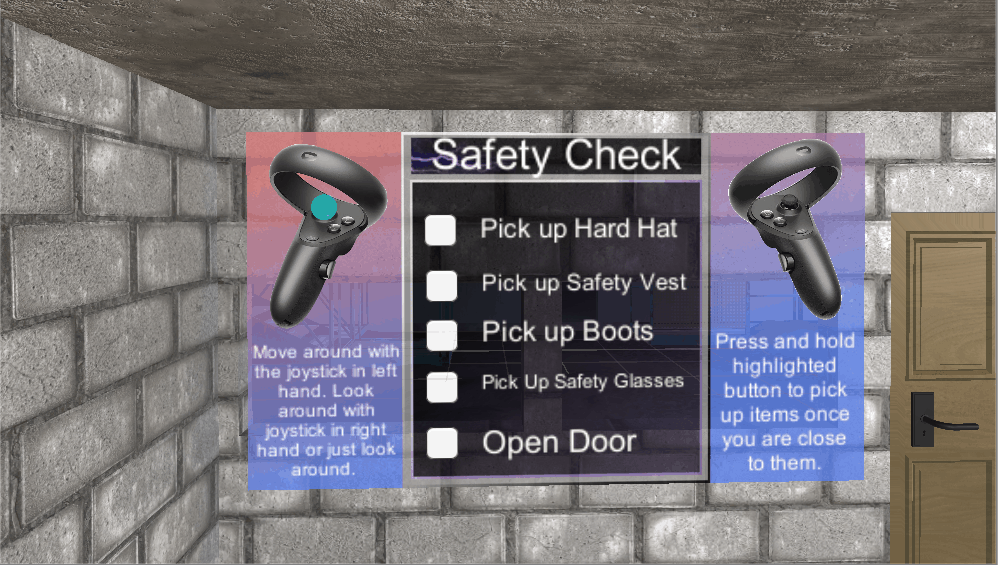
Creating The Instructional Board
The instruction board uses a simple UI created in Unity. It guides the user while they move and interact with the environment. The board had to recognize when a safety check item was completed. When the user grabs PPE, the board will add a check mark to the task. When the user completes all safety check items, the door unlocks. The board controls all these functions using scripts within Unity.
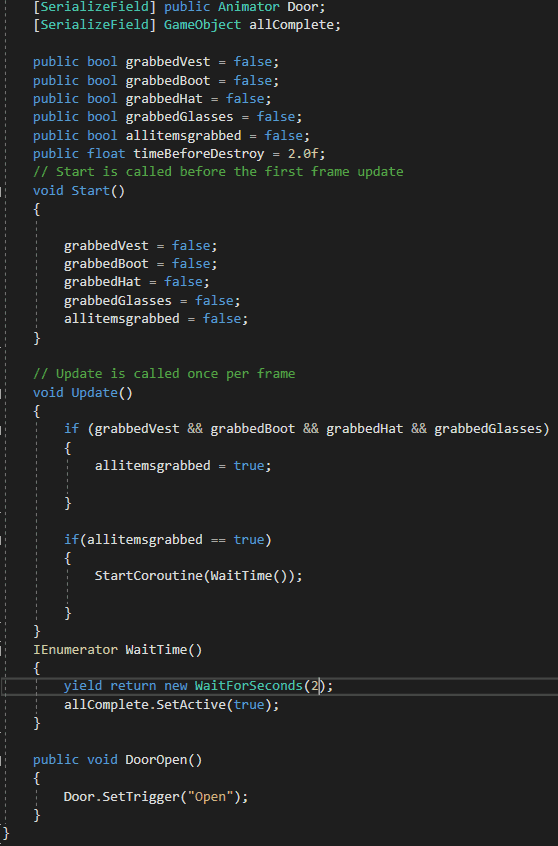
Adding Sound Effects To VR Objects
Sound is necessary to simulate real-world environments. For example, completing a task gives users a positive sound. When the user completes the training, it triggers a celebratory sound. We implemented sound effects by storing sounds within an empty game object. We used Unity scripts to trigger these sounds for specific user actions.
Realism vs Functionality in Virtual Reality
During app design and development, our VR development team discussed how much time we would spend creating a realistic environment. We decided that for the purpose of this proof-of-concept we would focus more on functionality and not on the fine details. For example, the PPE assets we purchased through Turbosquid did not include artwork for the boot interior. As a result, certain PPE appear hollow. Enterprise virtual reality applications with a realistic user-experience need custom assets. For a client, the custom virtual reality app development process would include storyboarding and interaction design. We would design and build custom assets, 3D models, create layered sound, and add realistic lighting to produce a captivating interactive experience. There are infinite possibilities to convey information through custom virtual reality development. The key is to provide an engaging user experience by balancing design and functionality.
Overcoming Challenges with VR Objects
During testing, we noticed that our 3D assets within the training room appeared hollow from certain angles. If a user grabbed the boots and looked inside one of the boots, they would see right through the object. This is an issue caused by the 3D asset. Because the 3D asset was not rendered to have a boot interior, nothing appears within our simulated environment. When developing for virtual reality, it is important to use assets that are fully formed. By creating custom assets, we can ensure that we account for some of the user-created variables that are inherent in a free movement virtual reality experience.
The Future of Construction
Our construction safety experience shows the benefits of virtual reality technology in training. Virtual reality in construction can reduce costs and improve critical business processes.VR training is just one of many solutions for construction businesses. We anticipate continued investment in virtual and augmented reality construction technology.
Invonto builds custom digital solutions for leading construction businesses. We focus on developing applications that improve operational efficiency, reduce waste, and maximize returns on capital projects. Construction isn’t the only industry taking advantage of virtual reality. We recently completed a virtual reality application for Merck, a global leader in pharmaceuticals. Interested in learning more? Contact us today to schedule your free consultation!
